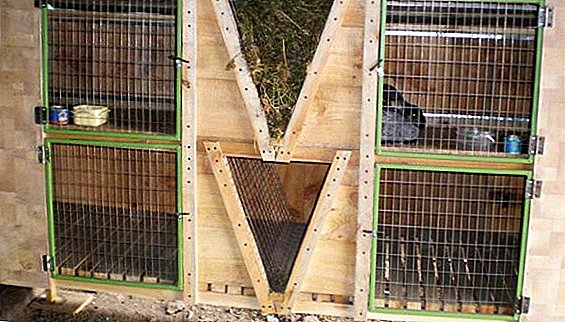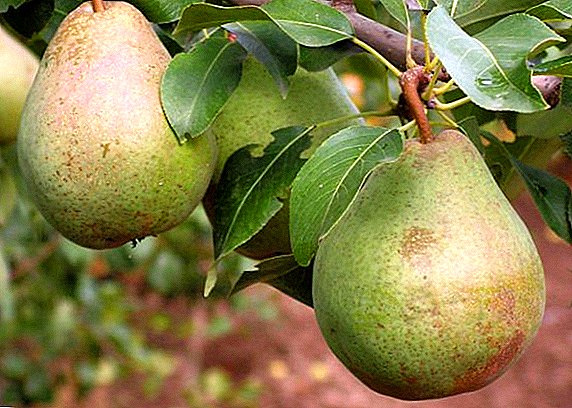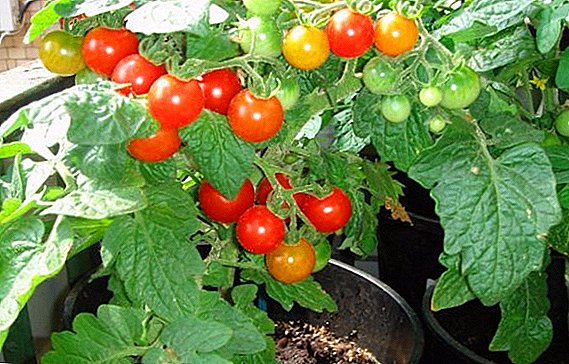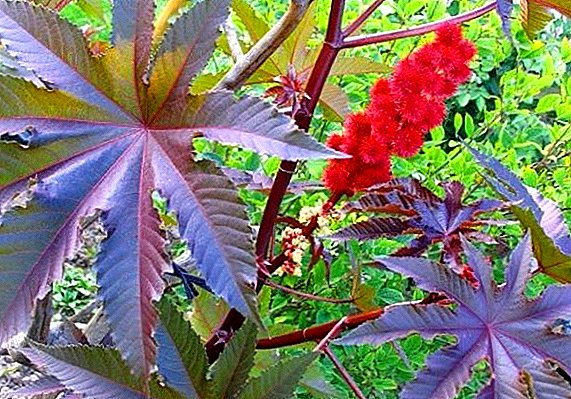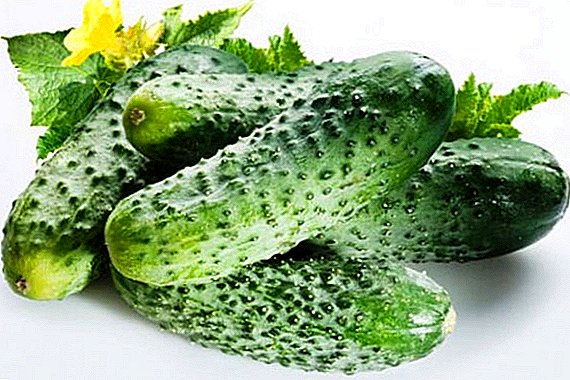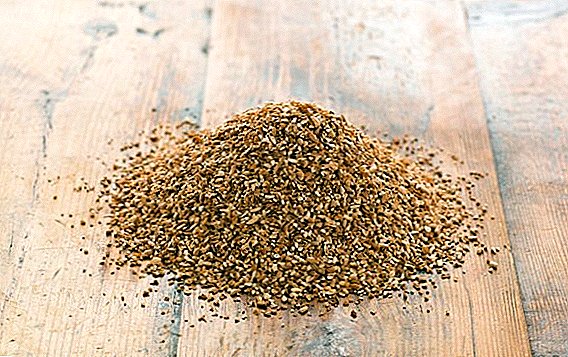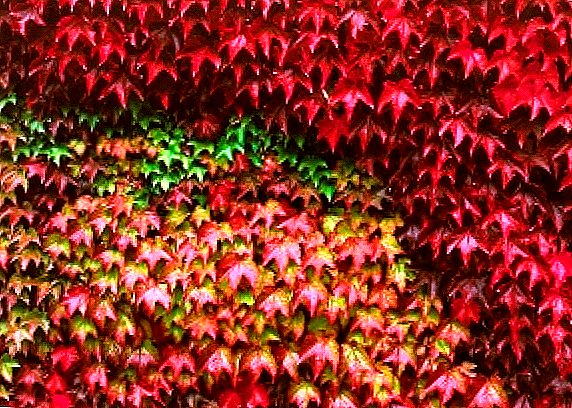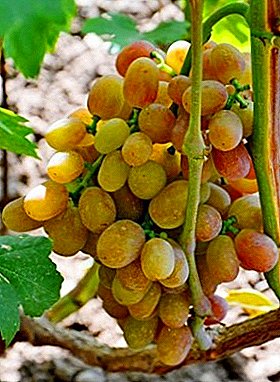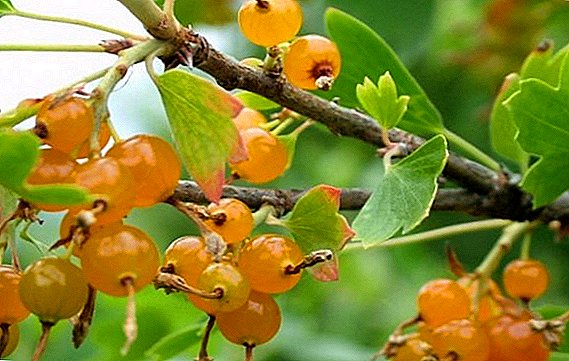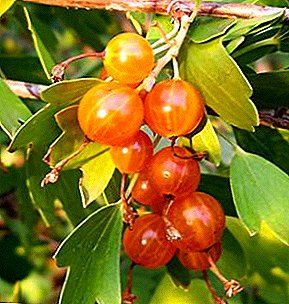 Currant has long been firmly "registered" in the suburban areas. Some grow several bushes, while others plant entire plantations. Berries of red, black and white lines are known to all. But there is another type that is gaining popularity.
Currant has long been firmly "registered" in the suburban areas. Some grow several bushes, while others plant entire plantations. Berries of red, black and white lines are known to all. But there is another type that is gaining popularity.
Consider what stands out golden currant, look into the description of the variety and see photos of this bush.
Description of the species
The natural habitat is the western United States, southwestern Canada and northern Mexico. In the Russian Federation, it is grown throughout the European part, in the Far Eastern regions and in the Caucasus.
It is a fairly high (up to 2-2.3 m) shrub with a rounded crown, straight branches and powerful long roots that can reach up to 1.5 m. The leaves are three-lobed, up to 5 cm in length, and have a glossy green color. In autumn, the color changes to orange, maroon, red or yellow-lemon. The same can happen in August (if the bush did not otplodonosil). In appearance, they look like gooseberries, and even smaller than usual ones for currants, therefore the plant is often mistaken for a hybrid. Meanwhile, it is a separate species.
Important! Bushes are not self-fertile, to ensure the harvest, you have to plant a currant of another variety nearby. So stimulate the emergence of new ovaries.At the very end of May, the flowering period begins, which lasts 2-3 weeks. At this time, on short racemes, small golden flowers are seen, exuding a pleasant fragrant aroma.
You will also be interested to learn about black, red and white currants.July is the time of fruiting. You can collect small berries. These "balls" 4-8 mm in size differ in color: most often they are rich yellow, although brown and dark fruits are also not uncommon. They taste sweet, with distinct sourness. The tail usually does not come off.
 Fruits in the third year after disembarkation, and the peak of productivity falls in the 5-7th years (with careful care, a good collection is obtained in the 8th year). Depending on the variety, 4-8 kg of berries are removed from the bush.
Fruits in the third year after disembarkation, and the peak of productivity falls in the 5-7th years (with careful care, a good collection is obtained in the 8th year). Depending on the variety, 4-8 kg of berries are removed from the bush.Such a currant compares favorably with other types of its unpretentiousness - it has a high resistance to drought.
How to buy seedlings
Before buying it is worth remembering the signs that indicate a healthy sapling. Here they are:
- Normal roots. A bush should have 3-5 main roots 15-20 cm long. If their bark has turned yellow - nothing terrible. The main thing - the presence of developed fibrous roots.
Did you know? 35-40 berries eaten cover the daily need of the body for vitamin C. Of course, it is better to eat freshly picked fruit.
- Two shoots of the aerial parts 30-40 cm long will be enough for the bush to start. They can offer and plant with one shoot, this option is also real - the roots "pull out" it.
- The state of the plant. Fractures, cuts, dangling on the "peel" twigs are excluded. Need a whole bush.
- Pay attention to the place of sale. If young bushes stood all day in the heat, there is a risk that they simply wither.
 When transporting the tips of the shoots and roots can be slightly damaged - they will have to be carefully trimmed to a healthy place. So that the rhizome does not dry up on the way to the dacha, it is wrapped with a wet rag and covered with a package on top.
When transporting the tips of the shoots and roots can be slightly damaged - they will have to be carefully trimmed to a healthy place. So that the rhizome does not dry up on the way to the dacha, it is wrapped with a wet rag and covered with a package on top.Landing rules
For an experienced gardener, planting such bushes on the site will not be difficult. Although for a beginner it is easy, if you know all the nuances of such work.
Optimal timing
You can plant bushes both in early spring and in autumn. The only thing is that the time is calculated so as to exclude the "falling" of an immature plant into freezing.  The spring “season” of planting falls on March, that is, before the start of intensive sap flow. It is important to “catch” the moment and catch before the buds bloom (of course, adjusted for weather conditions in the region).
The spring “season” of planting falls on March, that is, before the start of intensive sap flow. It is important to “catch” the moment and catch before the buds bloom (of course, adjusted for weather conditions in the region).
Important! In addition to the "bush" method for growing and used standard. As a trunk leave one powerful shoot in height of 70-75 cm, cutting off all the others. In time, other types of currant can be attached to such a tree.Many try to plant currants in the fall, in the first two weeks of October. During the winter, the soil will be compacted, the plant will get stronger and with the onset of heat will quickly grow.
Learn about the best varieties of currants for your site.
Choosing a place
Suitable for any composition of soil - from dry acidified to wet alkaline. Sandy loam or loam is also suitable. For groundwater, there is one requirement: location at a great depth (1 meter and below). A higher level will only harm the plantings.
The place should be well lit, if there is no such possibility - the partial shade is also suitable.  The plot is flat, often on the west or south-west side of the cottage.
The plot is flat, often on the west or south-west side of the cottage.
You can place a bush near the fence, departing from the fence about 1 meter.
Soil preparation is also important. The land is leveled, weeds are removed and shovels are dug up to the depth of the bayonet. For 2-3 weeks the soil is fertilized. On 1 square. m evenly contribute 6-8 kg of compost and 20-30 g of potash.
Did you know? You can see currants in almost every corner of the world. The only exceptions are Australia and Antarctica.
Stepwise landing process
Everything is ready for landing, proceed:
- digging a hole 50 x 60 cm;
- rotted manure is laid in the hole, adding a glass of wood ash and superphosphate to a glass;
- then it is filled with water;
- take the seedling and gently placed in the hole. At the same time, the root neck is deepened by 6-7 cm. Here there is one caveat - the plant is first planted at an angle (this is how new roots would be better to start). If you immediately insert a sapling straight, it is likely that new stems will not appear;
- It remains to sprinkle with earth, gradually tamping the soil with a toe in the direction of the trunk. A step-by-step pouring is also carried out: for example, a 3-4-year-old bush will have 3-4 buckets of water, while the young will need 5-7.
 The planting pattern is marked as 2.5 x 1.2 m. That is, it is undesirable to start up seedlings in one trench, otherwise they will simply mate with roots. Note that the best planting material is considered to be 2-3 years old bushes with 3-4 powerful shoots and long urinary roots (20-25 cm each). On their aboveground parts, 5-6 buds are left, the rest is removed by secateurs.
The planting pattern is marked as 2.5 x 1.2 m. That is, it is undesirable to start up seedlings in one trench, otherwise they will simply mate with roots. Note that the best planting material is considered to be 2-3 years old bushes with 3-4 powerful shoots and long urinary roots (20-25 cm each). On their aboveground parts, 5-6 buds are left, the rest is removed by secateurs.Competent care - a pledge of a rich harvest
We already know the difference between golden currant, how its planting is done, and now it is time to consider how the care of such bushes is made.
Important! Before planting, the rhizome can be held for 2-3 hours in a biologically active solution, then immersed in water for a couple of days. There is also an easier option - to keep in the water until the root discards a new lobe.
Watering, weeding and loosening
Frequent watering is not required, 3-5 approaches are enough during the growing season.
Water is poured into circular grooves, trying not to touch the leaves. The norm for a young bush is 10-20 liters. A more "aged" plant will need 30-35 liters of water.  For large plantations, the sprinkling method is suitable - this is how the necessary humidity is maintained, and it is not necessary to run around with buckets, it is enough to adjust the head.
For large plantations, the sprinkling method is suitable - this is how the necessary humidity is maintained, and it is not necessary to run around with buckets, it is enough to adjust the head.
Before blooming buds (in early spring) or after the leaves fall (at the end of September), moderate watering is carried out, which hardens the bushes and is aimed at increasing their yield in the future.
Weeding is done as needed: as soon as the weeds have appeared, they are immediately removed.
But it is desirable to loosen after each watering. "Filling" the ground, you will provide air access to the roots. Tightening is not worth it, otherwise the earth will take a crust and begin to crack.
Fertilization
The hardy look does not require frequent fertilizing.  The humus put in a pole will suffice at least for 2 years. Starting from the third year, in the spring the bushes are fed up: bird droppings or manure mixed with the complex “mineral water” are laid in the root furrows.
The humus put in a pole will suffice at least for 2 years. Starting from the third year, in the spring the bushes are fed up: bird droppings or manure mixed with the complex “mineral water” are laid in the root furrows.
In autumn, 4-4.5 kg of compost or humus can be laid under a bush. At the same time add a mixture of potassium sulfate and superphosphate (20 g). They are replaced by ash, which take half a cup.
It will be useful for you to learn about currant feeding in spring.Strong mineral compounds or "chemicals" are not used as fertilizers.
Mulching
Pour a layer of mulch after each watering, so retain moisture. As a coating for currants use:
- peat;
- dry grass;
- compost;
Did you know? Immature berries contain four times more vitamin C than ripe ones.
- manure. Rattered manure is laid out so that it does not touch the branches.
The film is also suitable for wintering, but it will have to put on the harvested bows and often correct - it should not be adjacent to the ground. If the dacha is visited infrequently in winter, it is better to refuse such material.
Pruning
Currant golden species pleases the gardener's eye, but she also needs timely pruning.
Let's say right away - in the first year it is not carried out. Starting from the 2nd year after disembarkation, this procedure is done annually in late autumn. To consolidate the result, you can spend it additionally in the spring (until the buds have blossomed). In the second year leave 3-5 most powerful young shoots. In time, they will become skeletal. Weak, shaded and interfering processes are removed. In the summer, young branches are slightly shortened by pinching the top two buds. This is important for the formation of a bush: the fruit grows on old branches and the growth of new shoots accelerates.
Important! After removing dry or diseased leaves and shoots, do not store them in the compost pit. It is better to burn it immediately - it will not allow diseases and pests to appear again.In the third or fourth year, everything repeats. Particular attention is paid to cleaning extra branches in the middle of the bush. On the layering, started on 2-3-year-old branches, leave no more than four buds. The bush is considered to be formed.
The 5-6th years of growth is the time of the first “youthful” pruning. The oldest branches are cut as low as possible. Parallel to this, dry, diseased, excess, or broken branches are removed.  The general scheme of the annual pruning is summarized as follows:
The general scheme of the annual pruning is summarized as follows:
- on last year's shoots clean the tops;
- on branches 2, 3, and 4 years, they reduce branching, leaving 2-3 buds there;
- of the young shoots leave the most promising;
- the best time for pinching will be mid-July;
- dry branches are removed immediately, regardless of the time of their appearance.
Digging between rows
An important role is played by the autumn digging. For heavy and dense soils, it is obligatory, whereas on lighter soils there will be sufficiently enhanced loosening.
Near the crown dig to a depth of 6 cm, so as not to damage the rhizomes. Outside the crown, you can take a depth of 10-15 cm.
Did you know? The largest in our area is currant varieties "Yadrenaya". The name is quite justified - the berries grow up to 7-8 g each.This simple but effective measure hardens the bushes, improves air flow to the roots and protects plants from pests that often hibernate in the upper layers of the soil.

Pest and disease treatment
The species is quite resistant to diseases and pest attacks, so prevention comes to the fore.
Preventive treatment is done before spring pruning. Until the juices are set in motion, use the "hot" method. It's simple: the water is heated to 80 degrees, and then the bushes are watered with it using a watering can with a divider. A 10-liter bucket is enough for 2 adult bush.
Learn more about currant diseases and pests.Before the buds have blossomed, the bushes are sprayed with 2% solution of Karbofos or Nitrofen. When the bushes go to growth, you can handle the "Fundazole" - periodic prevention will benefit. For completeness of effect, Bordeaux liquid of low concentration (up to 2%) is used.
After autumn pruning, the bushes themselves and the soil beneath them are densely sprayed with solutions of colloidal sulfur (1%) or Karbofos (2%).
If you carry out such activities in a timely manner, the risk of illness is significantly reduced.  With pests more difficult. They can go to the currants from the already affected crops or from a neighboring site. Gardeners especially bite various mites.
With pests more difficult. They can go to the currants from the already affected crops or from a neighboring site. Gardeners especially bite various mites.
Important! If the currant planting is only in your plans, pay attention to such "golden" varieties: "Isabel", "Ermak", "Laysan", "Shafak", "Uzbekistan", "Venus".A common spider mite produces itself as whitened or brown leaves that stop growing and dry out. To remove such a pest during the growth of the kidneys or immediately after flowering, use Karbofos 50% (take 20-30 g for 10 liters of water). Effective and homemade garlic-onion "mix", which allowed to brew day.
The bud mite inflates the buds on the leaves, which darken and gradually begin to die. It can appear at any time, and the methods of dealing with it are different. For example, during the ejection of the brush in the course is colloidal sulfur (10 liters - 75 g of suspension). After flowering, its concentration is reduced to 1%. In the same period, "Tedion" (0.4%) or "Ester sulfonate" (0.5%) is suitable.
The bark is often located on the bark. They get rid of it by spraying the bushes with nitrophenic paste in the form of a 2% solution (250 g per 10 l). It is effective in the spring, on sleeping buds. Later used "Karbofos" 50% (20-30 g per bucket).  The sawfly does not tolerate the Chlorofos solution (0.2-0.3%).
The sawfly does not tolerate the Chlorofos solution (0.2-0.3%).
Did you know? 1 kg of berries contains at least 700 thousand seeds. The weight of 1 thousand depends on the variety and varies from 0.9 to 1.8 g.The secretive glass bowl will die if you use "Aktar" 0.1% after flowering or dilute tablets like "Spark" in water. The folk method is mustard infusion with the addition of tansy, tomato tops and celandine.
The larvae of midge are destroyed by the same "Karbofos" (30 g / 10 l). On the same volume can be taken and 20 g of "Trichlormetaphos". The difficulty is that there are more of these parasites - they also added shoots to leaf larvae. You can distinguish them by pink or orange color. They are removed by the same formulations, but a couple of weeks after picking the berries, repeated processing is required.
Beneficial features
Currant, including golden, has its beneficial properties. Its fruits contain more vitamin A than any other berry. Carotin is also a lot - even more than apricots. Trace elements like pectin and anthocyanin are great for strengthening immunity. Contained in golden berries and fixative substances, which is useful for people with impaired gastrointestinal function.
To match the acids contained in it - ascorbic, citric, amber, malic and a number of others make currants an excellent addition to tea drinking.
Important! One of the best "neighbors" in the area for currants will be onions (garlic also repels pests). As for the "latka" predecessors, they can be any kind of vegetables.Berries can be consumed immediately, let on jams and jams, as well as freeze. They are also suitable as an ingredient in wines or liqueurs.
True, there is one thing that fans of different tea infusions should take into account. The fact is that the buds, leaves and flowers (especially young ones) contain prussic acid, and they cannot be taken for welding, as well as for infusion.
After learning all about breeding golden currant, many will want to plant a few bushes on the site. We hope that they will please their owners. Have a good harvest!


